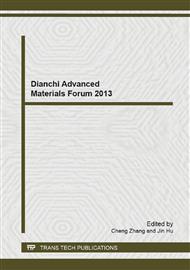[1]
J. Yang, M. Wachtler, M. Winter, et al., Sub-microcrystalline Sn and Sn-SnSb powders as lithium storage materials for lithium-ion batteries, Electrochem. Solid-state Lett. 2 (1999) 161-163.
DOI: 10.1149/1.1390769
Google Scholar
[2]
J. P. Maranch, A. F. Hepp, P. N. Kumta, High capacity, reversible silicon thin-film anodes for lithium-ion batteries, J. Electrochem. Soc. 6 (2003) A198-A201.
DOI: 10.1149/1.1596918
Google Scholar
[3]
J. -H. Ahn, G.X. Wang, J. Yao, H.K. Liu, S.X. Dou, Tin-based composite materials as anode materials for Li-ion, J. Power Sources. 119-121 (2003) 45-49.
DOI: 10.1016/s0378-7753(03)00122-8
Google Scholar
[4]
A. Netz, R. A. Huggins, W. Weppner, The formation and properties of amorphous silicon as negative electrode reactant in lithium systems, J. Power Sources. 119-121 (2003) 95-100.
DOI: 10.1016/s0378-7753(03)00132-0
Google Scholar
[5]
H. Kim, B. Han, J. Choo, J. Cho, Three-Dimensional Porous Silicon Particles for Use in High-Performance Lithium Secondary Batteries, Angew. Chem. Int. Ed. 47 (2008) 10151-10154.
DOI: 10.1002/anie.200804355
Google Scholar
[6]
J. K. Lee, W. Y. Yoon, B. K. Kim, Electrochemical behavior of Si nanoparticle anode coated with diamond-like carbon for lithium-ion battery, J. Electrochem. Soc. 159 (2012) A1844-A1848.
DOI: 10.1149/2.045211jes
Google Scholar
[7]
C. K. Chan, R. Ruffo, S. S. Hong, R. A. Huggins, Y. Cui, Structural and electrochemical study of the reaction of lithium with silicon nanowires, J. Power Sources. 189 (2009) 34-39.
DOI: 10.1016/j.jpowsour.2008.12.047
Google Scholar
[8]
M. G. Kim and J. Cho, Reversible and high-capacity nanostructured electrode materials for li-ion batteries, Adv. Funct. Mater. 19 (2009) 1497-1514.
DOI: 10.1002/adfm.200801095
Google Scholar
[9]
W. R. Liu, M. H. Yang, H. C. Wu, et al., Enhanced cycle life of Si anode for Li-ion batteries by using modified elastomeric binder, Electrochem. Solid-State Lett. 8 (2) (2005) A100-A103.
DOI: 10.1149/1.1847685
Google Scholar
[10]
J. Li, H. M. Dahn, L. J. Krause, D. B. Le and J. R. Dahn, Impact of binder choice on the performance of α-Fe2O3 as a negative electrode, J. Electrochem. Soc. 155 (11) (2008) A812-A816.
DOI: 10.1149/1.2969433
Google Scholar
[11]
J. Li, R. B. Lewis and J. R. Dahn, Sodium carboxymethyl cellulose a potential binder for Si negative electrodes for Li-ion batteries, Electrochem. Solid-State Lett. 10(2) (2007) A17-A20.
DOI: 10.1149/1.2398725
Google Scholar
[12]
R. R. Garsuch, D. B. Le, A. Garsuch, et al., Studies of lithium-exchanged nafion as an electrode binder for alloy negatives in lithium-ion batteries, J. Electrochem. Soc. 155 (10) (2008) A721-A724.
DOI: 10.1149/1.2956964
Google Scholar
[13]
J. -S. Bridel, T. Azais, M. Morcrette, J. -M. Tarascon and D. Larcher, Key parameters governing the reversibility of Si/carbon/CMC for lithium ion batteries, Chem. Mater. 22 (2010) 1229-1224.
DOI: 10.1021/cm902688w
Google Scholar
[14]
S. D. Beattie, D. Larcher, M. Morcrette, B. Simon and J. -M. Tarascon, Si electrodes for Li-ion batteries-a new way to look at an old problem, J. Electrochem. Soc. 155 (2) (2008) A158-A163.
DOI: 10.1149/1.2817828
Google Scholar
[15]
M. N. Obrovac and L. Christensen, Structural Changes in Silicon Anodes during Lithium Insertion/Extraction, Electrochem. Solid-State Lett. 7(5) (2004) A93-A96.
DOI: 10.1149/1.1652421
Google Scholar
[16]
S. Ohara, J. Suzuki, K. Sekine, T. Takamur, Li insertion/extraction reaction at a Si film evaporated on a Ni foil, J. Power Sources. 119–121 (2003) 591-596.
DOI: 10.1016/s0378-7753(03)00301-x
Google Scholar


